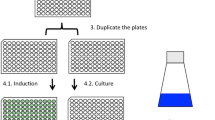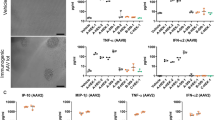Abstract
The chemokine stromal cell-derived factor-1α (SDF-1α) binds to the chemokine receptor CXCR4 that couples to pertussis toxin-sensitive G-proteins of the Gi/Go-family. CXCR4 plays a role in the pathogenesis of autoimmune diseases, human immunodeficiency virus infection and various tumors, fetal development as well as endothelial progenitor and T-cell recruitment. To this end, most CXCR4 studies have focused on the cellular level. The aim of this study was to establish a reconstitution system for the human CXCR4 that allows for the analysis of receptor/G-protein coupling at the membrane level. We wished to study specifically constitutive CXCR4 activity and the G-protein-specificity of CXCR4. We co-expressed N- and C-terminally epitope-tagged human CXCR4 with various Gi/Go-proteins and regulator of G-protein signaling (RGS)-proteins in Sf9 insect cells. Expression of CXCR4, G-proteins, and RGS-proteins was verified by immunoblotting. CXCR4 coupled more effectively to Gαi1 and Gαi2 than to Gαi3 and Gαo and insect cell G-proteins as assessed by SDF-1α-stimulated high-affinity steady-state GTP hydrolysis. The RGS-proteins RGS4 and GAIP enhanced SDF-1α-stimulated GTP hydrolysis. SDF-1α stimulated [35S]guanosine 5′-[γ-thio]triphosphate (GTPγS) binding to Gαi2. RGS4 did not enhance GTPγS binding. Na+ salts of halides did not reduce basal GTPase activity. The bicyclam, 1-[[1,4,8,11-tetrazacyclotetradec-1-ylmethyl)phenyl]methyl]-1,4,8,11-tetrazacyclotetradecane (AMD3100), acted as CXCR4 antagonist but was devoid of inverse agonistic activity. Halides reduced the maximum SDF-1α-stimulated GTP hydrolysis in the order of efficacy I− > Br− > Cl−. In addition, salts reduced the potency of SDF-1α at activating GTP hydrolysis. From our data, we conclude the following: (1) Sf9 cells are a suitable system for expression of functionally intact human CXCR4; (2) Human CXCR4 couples effectively to Gαi1 and Gαi2; (3) There is no evidence for constitutive activity of CXCR4; (4) RGS-proteins enhance agonist-stimulated GTP hydrolysis, showing that GTP hydrolysis becomes rate-limiting in the presence of SDF-1α; (5) By analogy to previous observations made for the β2-adrenoceptor coupled to Gs, the inhibitory effects of halides on agonist-stimulated GTP hydrolysis may be due to increased GDP-affinity of Gi-proteins, reducing the efficacy of CXCR4 at stimulating nucleotide exchange.







Similar content being viewed by others
Abbreviations
- AMD3100:
-
1-[[1,4,8,11-tetrazacyclotetradec-1-ylmethyl)phenyl]methyl]-1,4,8,11-tetrazacyclotetradecane
- BSA:
-
bovine serum albumin
- β2AR:
-
β2-adrenoceptor
- GPCR:
-
G-protein-coupled receptor
- GTPγS:
-
guanosine 5′-[γ-thio]triphosphate
- GAIP:
-
Gα-interacting protein
- RGS protein:
-
Regulator of G-protein Signalling protein
- SDF-1α:
-
stromal cell-derived factor-1α
- Sf9 cells:
-
Spodoptera frugiperda pupal ovary cells
References
Bajetto A, Bonavia R, Barbero S, Florio T, Schettini G (2001) Chemokines and their receptors in the central nervous system. Front Neuroendocrinol 22:147–184
Birnbaumer L (2007) Expansion of signal transduction by G proteins. The second 15 years or so: from 3 to 16 α subunits plus βγ dimers. Biochim Biophys Acta 1768:772–793
Birnbaumer L, Abramowitz J, Brown AM (1990) Receptor–effector coupling by G proteins. Biochim Biophys Acta 1031:163–224
Buckingham M (2006) Myogenic progenitor cells and skeletal myogenesis in vertebrates. Curr Opin Genet Dev 16:525–532
Chen W-J, Jayawickreme C, Watson C, Wolfe L, Holmes W, Ferris R, Armour S, Dallas W, Chen G, Boone L, Luther M, Kenakin T (1998) Recombinant human CXC-chemokine receptor-4 in melanophores are linked to Gi protein: Seven transmembrane coreceptors for human immunodeficiency virus entry into cells. Mol Pharmacol 53:177–181
Cheng Y, Prusoff WH (1973) Relationship between the inhibition constant (Ki) and the concentration of inhibitor which causes 50 per cent inhibition (I50) of an enzymatic reaction. Biochem Pharmacol 22:3099–3108
Costa T, Lang J, Gless C, Herz A (1990) Spontaneous association between opioid receptors and GTP-binding regulatory proteins in native membranes: specific regulation by antagonists and sodium ions. Mol Pharmacol 37:383–394
Ganju RK, Brubaker SA, Meyer J, Dtt P, Yang Y, Qin S, Newman W, Groopman JE (1998) The α-chemokine, stromal cell-derived factor-1α, binds to the transmembrane G-protein-coupled CXCR-4 receptor and activates multiple signal transduction pathways. J Biol Chem 273:23169–23175
Gerlach LO, Skerlj RT, Bridger GJ, Schwartz TW (2001) Molecular interactions of cyclam and bicyclam non-peptide antagonists with the CXCR4 chemokine receptor. J Biol Chem 276:14153–14160
Gierschik P, Sidiropoulos D, Steisslinger M, Jakobs KH (1989) Na+ regulation of formyl peptide receptor-mediated signal transduction in HL 60 cells. Evidence that the cation prevents activation of the G-protein by unoccupied receptors. Eur J Pharmacol 172:481–492
Gierschik P, Moghtader R, Straub C, Dietrich K, Jakobs KH (1991) Signal amplification in HL-60 granulocytes. Evidence that the chemotactic peptide receptor catalytically activates guanine-nucleotide-binding regulatory proteins in native plasma membranes. Eur J Biochem 197:725–732
Graber SG, Figler RA, Garrison JC (1992) Expression and purification of functional G protein α subunits using a baculovirus expression system. J Biol Chem 267:1271–1278
Gupta SK, Pillarisetti K, Thomas RA, Aiyar N (2001) Pharmacological evidence for complex and multiple site interaction of CXCR4 with SDF-1α: implications for development of selective CXCR4 antagonists. Immunol Lett 78:29–34
Guyon A, Nahon JL (2007) Multiple actions of the chemokine stromal cell-derived factor-1α on neuronal activity. J Mol Endocrinol 38:365–376
Higashijima T, Ferguson KM, Sternweis PC (1987) Regulation of hormone-sensitive GTP-dependent regulatory proteins by chloride. J Biol Chem 262:3597–3602
Houston C, Wenzel-Seifert K, Bürckstümmer T, Seifert R (2002) The human histamine H2-receptor couples more efficiently to Sf9 insect cell Gs-proteins than to insect cell Gq-proteins: limitations of Sf9 cells for the analysis of receptor/Gq-protein coupling. J Neurochem 80:678–696
Hristov M, Zernecke A, Liehn EA, Weber C (2007) Regulation of endothelial progenitor cell homing after arterial injury. Throm Haemost 98:274–277
Jones DT, Reed RR (1987) Molecular cloning of five GTP-binding protein cDNA species from rat olfactory neuroepithelium. J Biol Chem 262:14241–14249
Kryczek I, Wei S, Keller E, Liu R, Zou W (2007) Stroma-derived factor (SDF-1/CXCL12) and human tumor pathogenesis. Am J Physiol Cell Physiol 292:C987–C995
Kucia M, Jankowski K, Reca R, Wysoczynski M, Bandura L, Allendorf DJ, Zhang J, Ratajczak J, Ratajczak MZ (2004) CXCR4-SDF1 signalling, locomotion, chemotaxis and adhesion. J Mol Histol 35:233–245
Leopoldt D, Harteneck C, Nürnberg B (1997) G proteins expressed in Sf 9 cells: interactions with mammalian histamine receptors. Naunyn-Schmiedeberg’s Arch Pharmacol 356:216–224
Moepps B, Frodl R, Rodewald HR, Baggiolini M, Gierschik P (1997) Two murine homologues of the human chemokine receptor CXCR4 mediating stromal cell-derived factor 1α activation of Gi2 are differentially expressed in vivo. Eur J Immunol 27:2102–2112
Moepps B, Braun M, Knöpfle K, Dillinger K, Knöchel W, Gierschik P (2000) Characterization of a Xenopus laevis CXC chemokine receptor 4: implications for hematopoietic cell development in the vertebrate embryo. Eur J Immunol 30:2924–2934
Murphy PM (2002) International Union of Pharmacology. XXX. Update on chemokine receptor nomenclature. Pharmacol Rev 54:227–229
Ödemis V, Moepps B, Gierschik P, Engele J (2002) Interleukin-6 and cAMP induce stromal cell-derived factor-1 chemotaxis in astroglia by up-regulating CXCR4 cell surface expression. J Biol Chem 277:39801–39808
Offermanns S, Schultz G, Rosenthal W (1991) Identification of receptor-activated G proteins with photoreactive GTP analog, [α-32P]GTP azidoanilide. Methods Enzymol 195:286–301
Percherancier Y, Berchiche YA, Slight I, Volkmer-Engert R, Tamamura H, Fujii N, Bouvier M, Heveker N (2005) Bioluminescence resonance energy transfer reveals ligand-induced conformational changes in CXCR4 homo- and heterodimers. J Biol Chem 280:9895–9903
Rosenkilde MM, Gerlach LO, Jakobsen JS, Skerlj RT, Bridger GJ, Schwartz TW (2004) Molecular mechanism of AMD3100 antagonism in the CXCR4 receptor. Transfer of binding site to the CXCR3 receptor. J Biol Chem 279:3033–3041
Ross EM, Wilkie TM (2000) GTPase-activating proteins for heterotrimeric G proteins: regulators of G protein signalling (RGS) and RGS-like proteins. Annu Rev Biochem 69:795–827
Seifert R (2001) Monovalent anions differentially modulate coupling of the β2-adrenoceptor to Gsα splice variants. J Pharmacol Exp Ther 298:840–847
Seifert R, Wenzel-Seifert K (2001) Unmasking different constitutive activity of four chemoattractant receptors using Na+ as universal stabilizer of the inactive (R) state. Receptors Channels 7:357–369
Seifert R, Wenzel-Seifert K (2002) Constitutive activity of G-protein-coupled receptors: cause of disease and common properties of wild-type receptors. Naunyn-Schmiedeberg’s Arch Pharmacol 366:381–416
Seifert R, Lee TW, Lam VT, Kobilka BK (1998) Reconstitution of β2-adrenoceptor-GTP-binding-protein interaction in Sf9 cells—high coupling efficiency in a β2-adrenoceptor-Gsα fusion protein. Eur J Biochem 255:369–382
Tamamura H, Tsutsumi H, Fujii N (2006) The chemokine receptor CXCR4 as a therapeutic target for several diseases. Mini Rev Med Chem 6:989–995
Tsibris AM, Kuritzkes DR (2007) Chemokine antagonists as therapeutics. Focus on HIV. Annu Rev Med 58:445–459
Walseth TF, Johnson RA (1979) The enzymatic preparation of [α-32P] nucleoside triphosphates, cyclic [32P] AMP, and cyclic [32P] GMP. Biochim Biophys Acta 562:11–31
Ward RJ, Milligan G (2004) Analysis of function of receptor-G-protein and receptor-RGS fusion proteins. Methods Mol Biol 259:225–247
Wenzel-Seifert K, Seifert R (2000) Molecular analysis of β2-adrenoceptor coupling to Gs-, Gi-, and Gq-proteins. Mol Pharmacol 58:954–966
Wenzel-Seifert K, Hurt CM, Seifert R (1998) High constitutive activity of the human formyl peptide receptor. J Biol Chem 273:24181–24189
Wenzel-Seifert K, Arthur JM, Liu HY, Seifert R (1999) Quantitative analysis of formyl peptide receptor coupling to Giα1, Giα2, and Giα3. J Biol Chem 274:33259–32566
Wieland T, Seifert R (2005) Methodological Approaches. In: Seifert R, Wieland T (eds) G-protein-coupled receptors as drug targets (Methods and Principles in Medicinal Chemistry). Wiley-VCH, Weinheim, pp 81–120
Zhang WB, Navenot JM, Haribabu B, Tamamura H, Hiramatu K, Omagari A, Pei G, Manfredi JP, Fujii N, Broach JR, Peiper SC (2002) A point mutation that confers constitutive activity to CXCR4 reveals that T140 is an inverse agonist and that AMD3100 and ALX40-4C are weak partial agonists. J Biol Chem 277:24515–24521
Zhou H, Tai HH (1999) Characterization of recombinant human CXCR4 in insect cells: role of extracellular domains and N-glycosylation in ligand binding. Arch Biochem Biophys 369:267–276
Zhou H, Tai HH (2000) Expression and functional characterization of mutant human CXCR4 in insect cells: role of cysteinyl and negatively charged residues in ligand binding. Arch Biochem Biophys 373:211–217
Acknowledgments
We thank Dr. Erich Schneider for stimulating discussions as well as Mrs. Astrid Seefeld and Gertraud Wilberg for expert technical assistance. Thanks are also due to the reviewers of the paper for their constructive critique and suggestions.
This work was supported by the Research Training Program (Graduiertenkolleg) GRK 760 “Medicinal Chemistry: Molecular Recognition—Ligand–Receptor Interactions” of the Deutsche Forschungsgemeinschaft, the “International Study and Training Partnerships (ISAP) Program” of the Deutscher Akademischer Austauschdienst and by the National Institutes of Health COBRE Award 1 P20 RR15563 and matching support from the State of Kansas.
Author information
Authors and Affiliations
Corresponding author
Additional information
Patrick Kleemann and Dan Papa contributed equally to this work.
Rights and permissions
About this article
Cite this article
Kleemann, P., Papa, D., Vigil-Cruz, S. et al. Functional reconstitution of the human chemokine receptor CXCR4 with Gi/Go-proteins in Sf9 insect cells. Naunyn-Schmied Arch Pharmacol 378, 261–274 (2008). https://doi.org/10.1007/s00210-008-0313-8
Received:
Accepted:
Published:
Issue Date:
DOI: https://doi.org/10.1007/s00210-008-0313-8




